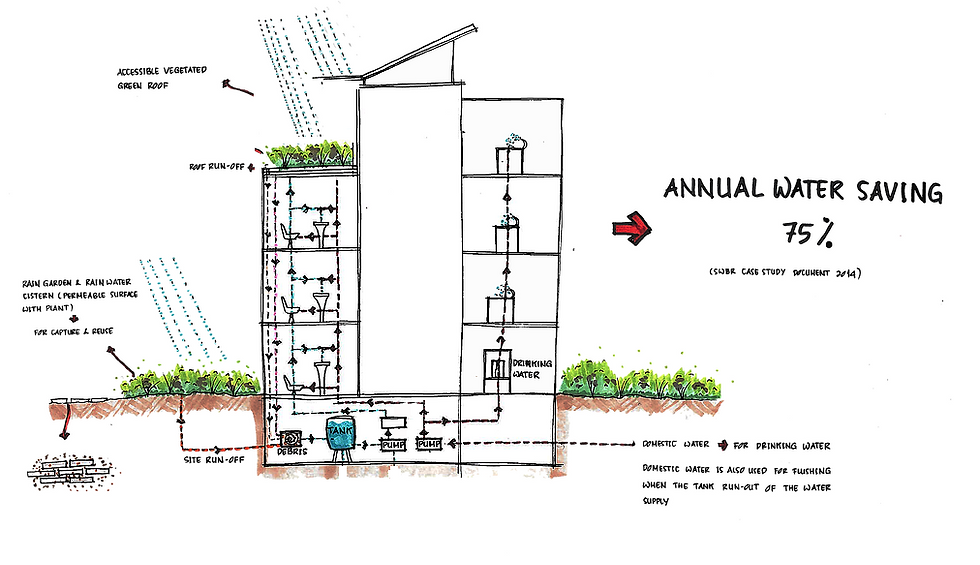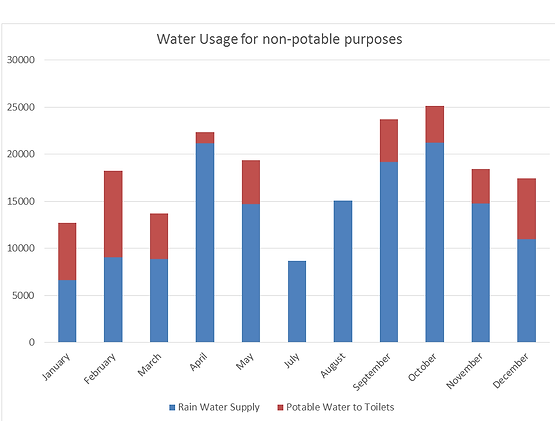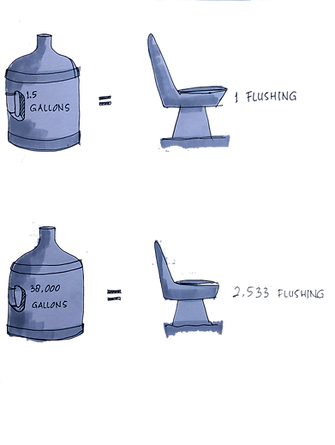GREEN ROOF AND WATER RECOVERY



Picture 2. Water Recovery Equipments in the GIS Basement


What is a Green Roof and Water Recovery System?
Green roof are generally categorized into two types: extensive and intensive. Extensive roofs have a depth of < 6 inches of growing media and are light-weight structures (approximately 10 to 35 lbs per square feet) and cost about $10 per square feet. These green roofs usually consist of grass, which cover large expanse of roof and require minimal maintenance. Intensive green roofs use deeper growing media (>6). They can include small trees and shrubs which creates a small garden on the rooftop. They tend to be more expensive (about $25 per square feet) and are heavier in weight (approximately 50-300 lbs. per square feet).
GIS (Golisano Institute of Sustainability) building has both extensive and intensive green roofs as can be seen in Picture 1. Both green roofs absorb green water and provide water supply for non-potable water consumption in GIS Building, such as flushing and sink.
Picture 1. Extensive Roof Garden (Left) and Intensive Roof Garden (Right) at GIS Rooftop
GREEN ROOF
Green Roof or eco-roof is a planted top that gives benefits of water harvesting, storm water management, energy conservation, pollution abatement and aesthetic value. (Florida Field Guide to Low Impact Development)
The main purpose of Green roofs is to mitigate storm water run-off. This is achieved through evapotranspiration which creates a time delay between storm event and water flow. It can reduce water runoff as much as 75%. This roof also serves as an insulator. The United States General Services Administration reports that green roofs lower the absorption of heat that would typically be absorbed by regular roofs. In peak summer where a black tar roof can reach 180 F, a white roof can reach 120 F, a green roof would reach only 80 F.
WATER RECOVERY SYSTEM
After the rain water is absorbed by green roof at the rooftop of GIS building, this water will be transported to the water recovery system. GIS has this water recovery sytem in the basement. As seen in Picture 2., this system consists of some elements such as storage compartment, pumps, and several pipes which connect the system with the green roof and transfer water into the non-potable water consumption.
The water recovery system consists of permeable surface ground with plant and permeable pathway made by brick. This system collects storm water in a large storage compartment. The water is filtered regularly in order to prevent microbial growth. After the treatment, the water will be used for non-potable purposes, like flushing in GIS building.


How do they work?
Picture 4. Water's Path

Picture 4. Water's Path
Picture 5. Illustration ofWater Recovery System in GIS Building

Picture 3. Layered Components of Typical Green Roof

Green Roof Components
Green roofs consist of several components such as metal flashing and parapet, growth media, root barier, edge metal, roof deck, gravel edge, roof drain, and drainage (Picture 3). (1) Flashing media and parapet function as the edge of the growth media; (2) Growth media consists of inorganic matter (soil, volcanic rock, etc) and organic material (wood, grass, sawdust, etc.); (3) root barier to protect membrane and consists of gravel, concrete, pvc, or copper; (5) drainage system; and (6) plants. These components work together to support water recovery system in the basement. As seen in Picture 4, the water that is not absorbed by the plants, will be filtered and transfered to water recovery system.
Besides that, green roofs also acts as insulation in the building. Plants reflect sun light which comes into the building so they reduce the heat in the rooms below. This landscaping does not require any permanent irrigation system and only native and adaptive plants have been used to let the plants survive even in the winter time.
By using green roofs in its rooftop, GIS building gets many benefits, not only for supplying non-potable water, but also reducing heat inside the building. This system is a win win solution for GIS building.
Water Recovery System in GIS Building
As shown in picture 5, this system has several components, such as green roof at the rooftop; rainwater pipe (which collects rain water from hard roof); rain garden, rain water cistern (permeable surface with plant), brick pathway (which let water absorbs through the gap between each brick). Getting absorbed by green roofs, rain water cistern, brick pathway and rain water pipe, rain water then flow to the water compartment in GIS basement after getting some treatment by debris equipment. This water is pumped up by one pump and is distributed to supply non-potable consumption in the building, such as flushing and sink. If the rainwater runs out, the supply will be done by domestic water through another pump in the basement. The domestic water is also used to supply drinking water for each floor in GIS building.
The water recovery system works very well in GIS Building. Based on SWBR case study Document 2014, this building has 75% of annual water saving. The water recovery system uses a single 1700 gallon tank to store rainwater. The tank size is based on the estimation of anticipated rainfall and water usage. The tank is expected to capture 100% of the water from the hard roof (13500 square feet) and 20% of the water from the green roof (3300 square feet). As the study of LEED certification, the total water captured was expected to be around 81600 gallons from the rain water and another 18000 gallons from condensates.


How do they help?
Picture 6. Water Usage for non-potable purposes

Picture 7. The amount of water saved by water recovery system and was used for non-potable purposes in GIS building (2014)

Data of Water Usage for non-potable purposes in GIS Buiding
Although data for June 2014 was unavailable, data for the rest of the year suggests that the rain water harvesting system provided between 50% (during winter months) and 100% (during summer months) of the water used for non-potable purposes. During these 11 months the system provided 77% of the non-potable water used, an impressive 150 kilo liters or 40,000 gallons, thereby surpassing the LEED certification test estimation of 75.9% as explained previously (Picture 6).
In 2014, rainwater also contributed significantly to the total water used in the building. Rain water substituted between 29% and 78% of the total water usage in the building. For these ten months, rain water contributed to 57% of the building total water usage. The total domestic water used was 28000 gallons while the total rainwater used was 38000 gallons (Picture 7).

Sustainability Benefits of Green Roofs and Water Recovery System
Green roofs and water recovery system in GIS building gives many benefits such as in sustainability aspects (economy, social, and environment). First, green roofs has a U-Value of 0.022. It means that it avoids heat to move through the building. As a result, the roof can lower surface temperature by 40F to 50F, reduce rainwater runoff by 50% to 85% and reduce energy demand in the building by as much as 15% to 30%. As a result, this green roofs give economy benefits by reducing the use of cooling system in summer time (Picture 8). Second, this lower temperature also creates better ambiance inside the building. As a result, in social aspect, this building creates happy people with good performances.
Third, The green roof in GIS is home to monarch butterfly which were a result of GIS' partnership with the Butterfly Beltway Project, a one-plot-at-a-time initiative of Rochester's Seneca Park Zoo. This condition gives benefits for GIS building both in social and environment aspect. It creates habitat for butterfly while in the same time creates a good relationship between GIS and Butterfly Beltway Project. Moreover, green roofs and water recovery system also gives other benefits for environment, such as water conservation and stormwater management in GIS building. This water is then be used for non-portable consumption in the building (Picture 7).
Picture 8. The Sustainability Benefits of Green Roofs and Water Recovery System in GIS Building
Overall, green roofs and water recovery system gives sustainability benefits for GIS building. It also gives direct education for student who learn in this building. Thus, this system become a win-win solution to prevent the excessive use of domestic water while in the same time gives education for people.
References
1. http://www.rit.edu/gis/images/leed_gis_crop.jpg
2. Florida Field Guide to Low Impact Development: Green Roofs/Eco Roofs . Program for Resource Efficient Communities, Florida: University of Florida, 2008.
3. Fischetti Mark Living cover [Journal] // Scientific American. - [s.l.] : Scientific American, 2008. - 05 : Vol. 104. - pp. 104-105.
4. Green Building Alliance Green Roofs [Online] // Green Building Methods. - November 15, 2015. - https://www.go-gba.org/resources/green-building-methods/green-roofs/>..
5. LEED WE credit 3: Water Use Reduction, Project# 1000003888 [Report] : LEED 2009 for New Construction and Major Renovations. - Rochester : LEED, 2009.
6. Marinelli Janet Urban Habitat [Online]. - December 2006. - November 15, 2015. - http://www.urbanhabitats.org/v04n01/introduction.html.
7. Pandey Nayan, Gupa D.K and Anderson M Rainwater harvesting as an adaptation to climate change [Journal] // Current Science. - 2003.
8. SWBR Case Study Document for Golisano Institute of Sustainability, Rochester Institute of Technology, 2014